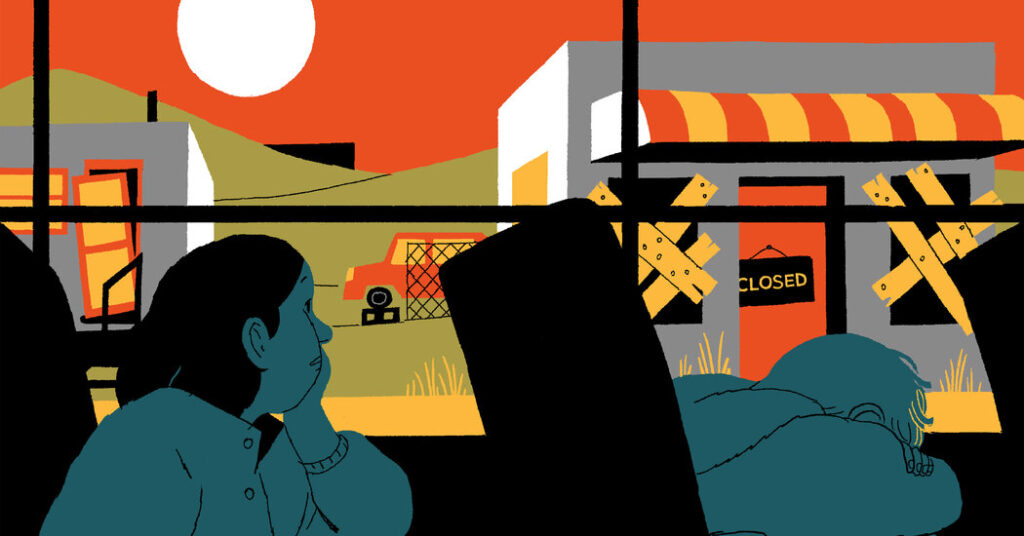Brooke Perry is an attendance officer and a homeless liaison in Champaign County, Ohio, which is about 45 minutes outside of Dayton. Every school day she is responsible for encouraging some of the hundreds of truant children recorded every year to return to school in five different districts.
Every home visit is a game of roulette. Perry does not know if she will encounter a child whose grandmother’s car has broken down and who simply needs a ride, or if she will be threatened — or even injured — by an out-of-control parent or child.
Perry remains stalwart through everything she witnesses, including drug-addicted family members and unsafe living environments. “If you saw the conditions they live in, you get immediately why going to school is the last thing on their minds,” Perry tells Beth Macy in Macy’s new book, “Paper Girl: A Memoir of Home and Family in a Fractured America.”
Macy, a former newspaper reporter and the author of “Dopesick,” the 2018 best seller about how the opioid crisis ravaged Appalachia, returned to her hometown, Urbana, Ohio, for the new book. She is trying to figure out how a working-class girl like her got to college and the middle class from Urbana 40 years ago, while that journey is much more arduous for today’s rural working class. Rural schools educate nearly 20 percent of America’s public school students. In Urbana, child poverty has tripled since Macy left home, and it was nearing 25 percent as of 2023. Poverty tends to be worse in rural areas than in urban ones.
Part of the answer is that the kids Perry is trying to reach now live in a different universe from some of the middle-class kids whom Macy befriended as a child. Those families gave Macy both practical help — meals, rides, affection — but also a sense of what was possible for her.
They’re mostly gone now, Macy told me when we spoke on the phone. As factories and job opportunities left Champaign County, the middle class “hollowed out,” drugs moved in and a sense of hopelessness lingered. “Mental health and trauma” are the two biggest issues for young people growing up there, Macy told me, and she said those were often downstream effects of the addiction crisis.
How do young people, especially those without supportive parents, make a future for themselves? Public trust in higher education has plummeted over the past decade, and I often hear people grouse that, rather than racking up student loans for a degree in ethnic basket weaving or whatever, kids just need to learn a trade. This advice seems to be doled out to kids eyeing college and those looking for work after high school graduation.
While learning a trade is excellent advice for many students, it is not the cure-all for inequality that our commerce secretary, Howard Lutnick, hopes it might be when he says he wants Harvard to build vocational schools as part of its deal with the government and touts “the tradecraft of America, our high school-educated Americans,” who are “going to have the greatest resurgence of jobs in the history of America.” (Despite the griping about useless degrees, the top two majors for bachelor’s degrees are business and health professions or related programs. The return on investment of a college education is still pretty good, too.)
I sometimes detect a blithe condescension to the “learn a trade” advice, as if learning how to weld or how to become an HVAC specialist or a cosmetologist is easy. These jobs can require the same kinds of executive functioning, people skills and intelligence that a college education requires, just applied differently. While the training for these jobs often takes less time than it does to earn a bachelor’s degree, it doesn’t come for free, either — and it’s puzzling that the current administration claims to want to support the trades but has attempted to halt funding for programs like Job Corps, which is designed to prepare low-income students for the work force, with a majority in trade programs.
The students who are struggling the most in places like Urbana are living in such dire circumstances, and battling against so much childhood trauma, even getting them to finish high school is a feat. The two students Macy features most heavily in the book, Silas and Maddie, were both victims of abuse, and faced significant mental health challenges as a result. Macy told me that the longtime teachers in Urbana she interviewed have to help kids learn how to human, because their basic life skills have been so atrophied.
What does that mean in practice? “Teaching them not to answer ‘two weeks’ when a prospective employer asks how many days of work is acceptable to miss during your first six months on the job. The correct answer is zero,” Macy writes. She told me, “Not all of them get these skills modeled for them, and that’s why it’s so important that we start to shore these systems up.” Often, public schools are among the last institutions standing in rural America, and we have to make sure they have what they need.
While “Paper Girl” is a sad and sobering read, Macy — who is running for Congress in Virginia’s Sixth District — has both big and small solutions to what ails the traumatized kids of rural America. The one with the most potential is that rural schools need better access to wraparound services, providing students with necessities like food, but also health care in the form of school nurses and counselors on site.
Catharine Biddle, who is an associate professor at the University of Maine and researches rural education, explained that while these services are also in demand in high-need urban and suburban districts, it’s a particular challenge to offer them in rural America. Most school systems run on economies of scale and a per-student funding model; it poses a great challenge to provide wraparound services to districts with fewer students who have a lot of needs and who are also spread out. Rural districts already face a teacher shortage, and earlier this year, the federal Department of Education cut funding to teacher training programs that might have helped alleviate some of those shortages.
In one paper Biddle wrote, where she spoke to over 100 educators in rural Maine about how they dealt with children with adverse childhood experiences, a teacher mentioned that the school nurse is on site just once a month, and that teachers feel as if they are acting as ad hoc social workers on a daily basis.
Into this breach steps someone like Perry. As Macy puts it: “The district needed about 10 of her.” Instead of funding even a second Perry, the State of Ohio has allowed a universal voucher system to leech money from the public school system. (Earlier this year, an Ohio judge ruled that the program violated the state constitution, but voucher proponents are appealing the ruling.) Vouchers, The New Yorker’s Alec MacGillis points out, mostly benefit wealthy families who are already sending their children to private, often religious, schools.
As the unluckiest students get left behind in places like Urbana and middle-class kids become more concerned about A.I. decimating the white-collar job market, my dark prediction is that kids with more stable families and better developed life skills will occupy the trade jobs that used to be a reliable route to the middle class.
We need to support working-class kids before the 21st century abandons them completely.
End Notes
-
I have been off the Real Housewives lately — the magic has been gone for a while from my favorite franchises. But I am intrigued by the trailer for a new entrant to the stable: “The Real Housewives of Rhode Island.” While it bears (in my experience) zero resemblance to the actual state of Rhode Island, hearing someone say “She married her sister’s boyfriend” is enough for me to at least watch the pilot.
-
In Saturday’s newsletter, I wrote about a new survey suggesting that 40 percent of women ages 15-44 are considering leaving the United States. If this describes you, drop me a line here about why, and where you think you may go. I may write about this in a future newsletter, but also, I’m just curious!
The post How Rural Kids Got Left Behind appeared first on New York Times.




